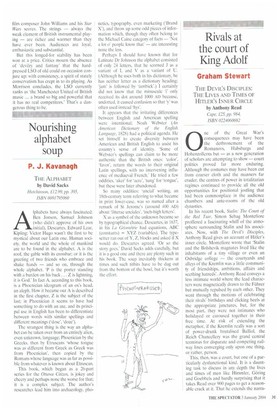Nourishing alphabet soup
P. J. Kavanagh
THE ALPHABET by David Sacks Hutchinson, £12.99, pp. 395, ISBN 0091795060 Alphabets have always fascinated: Ben Jonson, Samuel Johnson (who didn't approve of his own initial), Descartes, Edward Lear, Kipling; Victor Hugo wasn't the first to be mystical about our Latin one. Human society, the world and the whole of mankind are to be found in the alphabet. A is the roof, the gable with its crossbar; or it is the greeting of two friends who embrace and shake hands — and so on, through the whole alphabet. 'P is the porter standing with a burden on his back. . . Z is lightning, it is God.' In fact A. according to this book, is a Phoenician ideogram of an ox's head, an aleph. How it became our A is described in the first chapter, Z is the subject of the last; in Phoenician it seems to have had something to do with an axe, and its principal use in English has been to differentiate between words with similar spellings and different meanings ('dose', `doze').
The strangest thing is the way an alphabet can be taken over from an entirely alien, even unknown, language; Phoenician by the Greeks, then by Etruscans 'whose tongue was as different from Greek as Greek was from Phoenician', then copied by the Romans whose language was as far as possible from whatever is known about Etruscan.
This book, which began as a 26-part series for the Ottawa Citizen, is jokey and cheery and perhaps none the worse for that; it is a complex subject. The author's researches lead him into archaeology, pho
netics, typography, even marketing (Brand X'), and throw up some odd pieces of information which, though they often belong to the Michael Caine category of facts — 'Not a lot a' people know that' — are interesting none the less.
Perhaps I should have known that for Latinate Dr Johnson the alphabet consisted of only 24 letters, that he scorned J as a variant of I, and V as a variant of U. (Although he uses both in his dictionary, he has neither letter as a dictionary heading; 'jam' is followed by 'iambick'.) I certainly did not know that the minuscule T only received its dot around 1000 AD because, undotted, it caused confusion so that 'y' was often used instead 'hys'.
It appears that the irritating differences between English and American spelling were intentional; Noah Webster On American Dictionary of the English Language, 1828) had a political agenda. He set himself to create diversity between American and British English to assist his country's sense of identity. 'Some of Webster's spellings can claim to be more authentic than the British ones: 'color', `favor', return the words to their original Latin spellings, with no intervening influence of mediaeval French.' He tried a few oddities, `aker' for `acre', 'twig' for 'tongue', but these were later abandoned.
So many oddities: 'uncial' writing, an 18th-century term referring to what became in print lower-case, was so named after a remark of St Jerome's (around 400 AD) about 'litterae unciales', 'inch-high letters'.
X as a symbol of the unknown became so by typographical chance. Descartes, in 1637, in his La Geometrie had equations, ABC (constants) = XYZ (variables). The typesetter ran out of Y, 7, blocks and asked if X would do. Descartes agreed. 'Or so the story goes,' David Sacks adds carefully, but it is a good one and there are plenty such in his book. The soup inevitably thickens at times and such titbits have to be dug out from the bottom of the bowl, but it's worth the effort.


























































 Previous page
Previous page